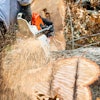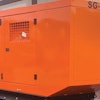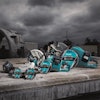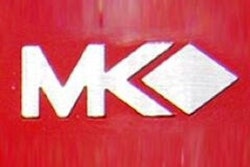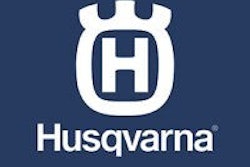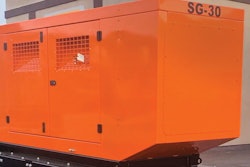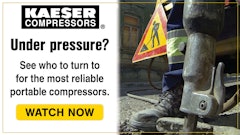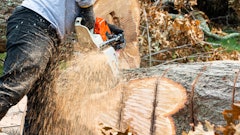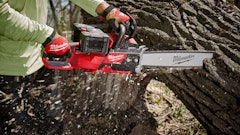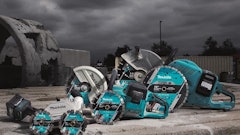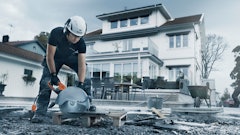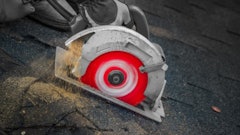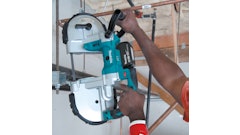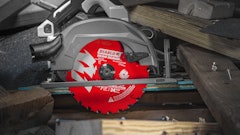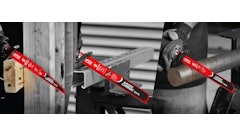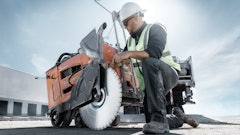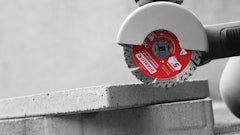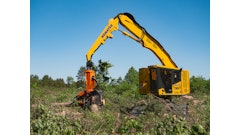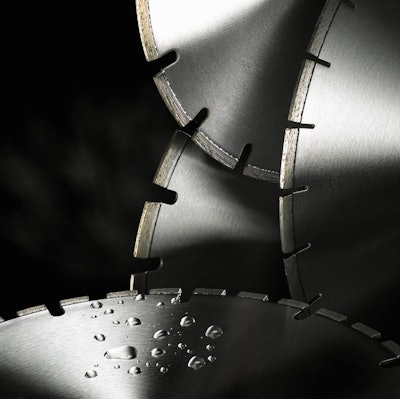
On the surface, renting diamond blades is a hugely profitable and simple proposition - what rental item has more ROI potential and requires less maintenance? Despite these advantages, blade rentals need to be taken seriously because if handled incorrectly, they can result in lost revenue, dissatisfied customers and even personal injury.
The best way to avoid negative blade rentals is to ensure your staff is well trained on proper blade selection and is able to effectively communicate that knowledge to your customers.
“The counter person should be able to explain to the customer the proper technique for using the blade with the material the customer plans to cut,” notes Brian Delahaut with MK Diamond Products. “This explanation should include how much water to use when using the blade wet, how to dry cut when using the blade with a high-speed saw, and how to effectively use step cutting to improve cutting performance.”
Often, however, inexperienced counter employees assist rental customers with blade selection. The biggest mistake that employee can make is not asking what application the blade will be used for, and whether the customer has experience with using a diamond blade.
According to Kyle Thuenemann with Prime Source, using a diamond blade for an application it's not designed for can result in damage to the blade, damage to the saw and worse, serious injury to the operator and/or anyone nearby. "The worst case scenario was a contractor who rented a diamond chainsaw and was cutting dry when he should have been cutting wet and a segment came off the chain, going into the contractor's skull, killing him on the spot," Thuenemann said.
Thankfully, the worst case scenario is not the most common one. Renting a blade for the wrong application most often results in poor performance and a dissatisfied customer. "If given the wrong blade, the customer will find that it is either slow cutting or wears out exceptionally fast," Delahaut says. “Proper blade specifying at the time of rental will ensure a satisfied customer, higher profit margins and improved safety during the rental."
Guard against disaster
To protect customers from harm and their businesses from loss, rental companies should have a focused and directed program which starts the moment the blade comes out of the box, says Delahaut. “Each blade needs to be labeled or marked with the proper application. Inspection procedures have to be in place every time a blade goes out and comes in from rental. If a blade shows any signs of fatigue it should not be rented, even if it has segment life remaining. If the proper inspection procedures are in place, the rental yard can assess if the blade was damaged as a result of customer abuse or the wrong blade for the application."
You might be wondering about your business’ liability if a customer misuses a blade and becomes injured in the process. According to Delahaut, this really depends on if the failure was a result of a manufacturing defect or if it was rented improperly.
“This is why rental records are so critical in any kind of injury to document the type of blade, the application and number of rentals,” he says. “Rental yards should put the intended application on the rental document at the time of the rental. I think having a digital picture of the condition of the blade at the time of rental would be a good means of protecting both the manufacturer and the rental yard if an injury occurred from use.”
Delahaut adds that it’s always important for rental businesses to ask the blade manufacturer to name them as an additional insured and to understand if the manufacturer has insurance that is Claims Made or Per Occurrence. Claims Made insurance coverage will respond to incidents arising on or after the policy retroactive date and which are reported during the term of the policy. Per Occurrence insurance coverage will respond to incidents arising from the coverage period, regardless of when those claims are reported.
Questions to ask
To improve the chances for a satisfying rental for your customer and a profitable one for your business, be sure employees consider the following questions when renting blades to customers:
- What is the application (material being cut)?
- How much cutting does the customer need to perform?
- What are the customer's expectations of how the blade will perform?
- What type of equipment will be used?
- How experienced is the customer in using diamond blades?
- Is it better to rent the blade or sell the customer the blade?
According to Ted Skaff at Pearl Abrasive, it’s also important to ask the horsepower rating of the saw the customer plans to use with the blade. Using a general-purpose blade on a high-speed saw, for example, is not advantageous. “It can result in premature wear and inferior production,” he says. “It’s possible that your $200 to $300 blade will wear out way too fast, resulting in poor ROI.”
Richard Tremain with Husqvarna adds, “High horsepower and harder materials to cut can both impact the life of a saw blade by overloading the diamonds. The blade design and composition should be tailored to those conditions to offer optimum sawing performance.”
He continues, “Different types of equipment call for different blades to be used. However, in some cases you can use the same blade on different types of equipment. For example some blades can be used with a power cutter, flat saw or masonry saw. Blades that can be used with different equipment will work best when the various saws have similar horse power and rotational speed (RPM).”
Blade selection
There are myriad blade choices and as many factors to consider when choosing one for your customer. There are blades that cut wet, blades that cut dry, those that are intended for green concrete and those designed for cured concrete. Selecting the right one for your customer takes knowledge.
Wet vs. dry - “Wet sawing is normally used when a customer is doing deep sawing in asphalt or concrete,” Delahaut says. “Wet cutting is also used as a means of dust suppression. While dry cutting is generally the preferred method by many contractors, state/local regulations might prevent the use of dry cutting operations.”
Delahaut continues, “Wet verses dry is dependent on the type of cutting and the customer preference. However, in some cases only wet cutting can be used. This is why the rental yard should question the application and know the regulations before the diamond blade is rented.
“Any dry-cutting blade can be used wet, but wet-cutting blades must be used wet,” adds Skaff. “If not, it will result in segment breakage. When one segment is gone, the blade is weak and should not be used.”
Delahaut notes that many rental businesses have moved from wet-specific blades to more general-purpose dry blades because of their versatility.
"Dry cutting blades are generally ideal for brick and block applications or shallow cutting no more than 5 inches deep," says Thuenemann. "Wet-cutting blades are ideal for deeper cuts where the water can flush out the cut and keep the blade cool due to the increased friction of the blade’s deeper embedment."
He continues, "Dry-cutting blades should be kept to open air areas and not enclosed spaces. You should also always wear a respirator when cutting dry. Wet-cutting blades help suppress the dust generated by cutting, and could be used in open air areas or in enclosed areas. It's also recommended to wear a respirator while cutting with a wet blade as well."
Green vs. cured concrete - The general formula for choosing the right blade for the type of material being cut is you need a hard bond for soft materials (such as green concrete or asphalt) and a soft bond for harder materials (such a cured concrete). The reason is that effective cutting relies on the diamonds in the blade segment constantly becoming exposed to the material being cut. When a softer bond meets a harder material, more diamonds are exposed as the blade wears, creating an effective cut. By the same token, a hard bond meeting a softer material keeps those diamonds exposed effectively as well.
“A hard bond against a hard material is going to cut,” says Skaff, “but it’s not going to cut fast or last long, so you’ll get less production and ROI. There is wiggle room, but it’s important to be careful when choosing a blade.”
“Green concrete is very abrasive and requires a special bond to deal with the abrasive nature of the concrete after it has been poured,” Delahaut explains. “Also, when cutting green concrete the cut is not very deep and is generally dry. Cured concrete is a completely different application as the concrete has set and is hard and generally cut wet. The challenge when cutting cured concrete is that the cut is full depth and the blade has to traverse cutting through the aggregate and possibly re-bar, which can present additional challenges.”
"Diamond Blades are rated on a scale of 1-10 on bond rating," Thuenemann adds. "One is the softest for critically hard material with reinforced steel and ten is the hardest for your more abrasive material. A number five bond blade generally can cover most applications, but with limited performance and life."
Premium vs. economy - There is also the question of whether it makes sense to invest in premium diamond blades or economy blades. According to Tremain, there is a time and place for both. “For smaller jobs or occasional use, a low-priced blade may be preferable,” he says. “For larger jobs or regular use, a higher-priced blade will actually be less expensive to use because it will deliver the lowest cost per cut.”
According to Skaff, it depends on your customer base. Premium blades will cut more over the life of the blade, so you’ll get the maximum ROI since the price per cut is lower. Low-end blades, on the other hand, provide less productivity but require less initial cash outlay.
“In the rental market, when you have lots of different people renting your blades, it might be best to go with something in the middle of the road,” says Skaff. “If you end up with a lot of wear and tear on your blade, you’re having it on a mid-level blade, which costs less than a premium one. Some people don’t want to tie up all their cash flow on one or two premium blades. They’d rather spread that around a little more.”
He continues, “On the other hand, if all your customers are pros and they prefer premium blades, then it makes sense to stock those because there is less downtime for blade changes. Downtime is huge in construction. Every time your customer has to stop and change his blade, it’s not just the few minutes it takes to do that. He’s going to use that time to also get some coffee or smoke a cigarette and suddenly, it’s a half hour of time, not just a few minutes. Anything you can do to minimize his downtime is a plus.”
The importance of training
Proper training of counter employees is vital to successful blade rentals. Skaff notes that reputable suppliers offer product training classes to review the dos and don’ts of blade rentals and owners and employees need to take advantage of this. “No one has the time for training, but rental businesses shouldn’t shut the blade manufacturer out on this. They should encourage employees to take part in product training.”

